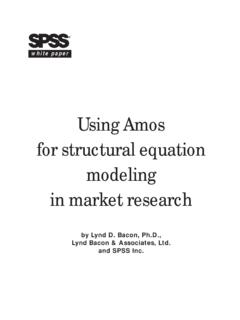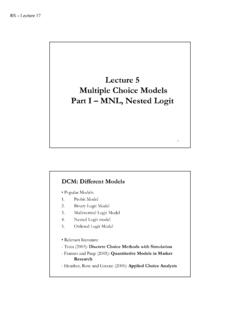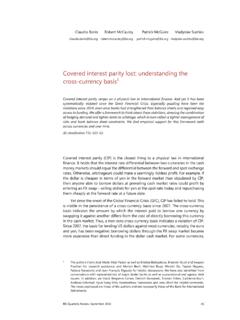Transcription of Chapter 7 - Arbitrage in FX Markets
1 Susmel FINA 4360 International Financial Management Dept. of Finance Univ. of Houston Chapter 7 - Arbitrage in FX Markets Last Lecture We went over effect of government on St FX rate regimes: Fixed, free float & mixed. CB sterilized (no effect on domestic Money Markets ) and non-sterilized interventions. This Lecture Effect of Arbitrage on St Arbitrage Definition: It involves no risk and no capital of your own. It is an activity that takes advantages of pricing mistakes in financial instruments in one or more Markets . That is, Arbitrage involves (1) Pricing mistake (2) No own capital (3) No Risk Note: The definition we used presents the ideal view of (riskless) Arbitrage .
2 Arbitrage , in the real world, involves some risk (the lower, the closer to the pure definition of Arbitrage ). We will call this Arbitrage pseudo Arbitrage . There are 3 types of Arbitrage : (1) Local (sets uniform rates across banks) (2) Triangular (sets cross rates) (3) Covered (sets forward rates) 1. Local Arbitrage (One good, one market) It sets the price of one good in one market. Law of one price: the same good should trade for the same price in the same market. Example: Suppose two banks have the following bid-ask FX quotes: Bank A Bank B USD/GBP Taking both quotes together, Bank A sells the GBP too low relative to Bank B s prices.
3 (Or, conversely, Bank B buys the GBP too high relative to Bank A s prices). This is the pricing mistake! Sketch of Local Arbitrage strategy: (1) Borrow USD (<= No own capital!) (2) Buy a GBP from Bank A (at ask price SAt,ask = USD ) (3) Sell GBP to Bank B (at bid price SBt,bid = USD ) (4) Return USD and make a = USD .02 profit ( per USD borrowed) Local Arbitrage Notes: All steps should be done simultaneously. Otherwise, there is risk! (Prices might change). Bank A and Bank B will notice a book imbalance: - Bank A: all activity at the ask side (buy GBP orders , GBP undervalued at SAt,ask ) - Bank B: all activity at the bid side (sell GBP orders , GBP overvalued at SBt,bid ).
4 Both banks will notice the imbalance and they will adjust the quotes. For example, Bank A will increase SAt,ask and Bank B will reduce SBt,bid, say to USD/GBP and USD/GBP, respectively. 2. Triangular Arbitrage (Two related goods, one market) Triangular Arbitrage is a process where two related goods set a third price. In the FX Market, triangular Arbitrage sets FX cross rates. Cross rates are exchange rates that do not involve the USD. Most currencies are quoted against the USD. Thus, cross-rates are calculated from USD quotations , the most liquid quotes. The cross-rates are calculated in such a way that arbitrageurs cannot take advantage of the quoted prices.
5 Otherwise, triangular Arbitrage strategies would be possible. Example: Suppose Bank One gives the following quotes: SJPY/USD,t = 100 JPY/USD SUSD/GBP,t = USD/GBP SJPY/GBP,t = 140 JPY/GBP Take the first two quotes. Then, the implied (no- Arbitrage ) JPY/GBP quote should be: SIJPY/GBP,t = SJPY/USD,t x SUSD/GBP,t = 160 JPY/GBP > SJPY/GBP,t At SJPY/GBP,t = 140 JPY/GBP, Bank One undervalues the GBP against the JPY (with respect to the first two quotes). This is the pricing mistake! Sketch of Triangular Arbitrage (Key: Buy undervalued GPB with the overvalued JPY): (1) Borrow USD 1 (2) Sell USD/Buy JPY at SJPY/USD,t = 100 JPY/USD i,e, sell the USD for JPY 100.
6 (3) Sell JPY/Buy GBP at SJPY/GBP,t = 140 JPY/GBP , sell JPY 100 for GBP (4) Sell GBP/Buy USD at SUSD/GBP,t = USD/GBP , sell the GPB for USD (5) Return loan, keep profits : : USD ( per USD borrowed). The triangle: JPY Sell USD at Sell JPY at St = 100 JPY/USD St = 140 JPY/GBP USD GBP Sell GBP at St = USD/GBP : Bank One will notice a book imbalance (all the activity involves selling USD for JPY, selling JPY for GBP, selling GBP for USD.) and will adjust quotes. Say: SJPY/USD,t (say, SJPY/USD,t = 93 JPY/USD). SUSD/GBP,t (say, SUSD/GBP,t = USD/GBP). SJPY/GBP,t (say, SJPY/GBP,t = 145 JPY/GBP).
7 There is convergence between SIJPY,GBP,t & SJPY,GBP,t: SIJPY,GBP,t (= SJPY,USD,t x SUSD/GBP,t ) SJPY,GBP,t Again, all the steps in the triangular Arbitrage strategy should be done at the same time. Otherwise, we ll be facing risk and what we are doing should be considered pseudo- Arbitrage . It does not matter which currency you borrow (USD, GBP, JPY) in step (1). As long as the strategy involves the step Sell JPY/Buy GBP (following the direction of the arrows in the triangle above!), you should get the same profit as a %. 3. Covered Interest Arbitrage (Four instruments -two goods per market-, two Markets ) Open the third section of the WSJ: Brazilian bonds yield 10% and Japanese bonds 1%.
8 Q: Why wouldn't capital flow to Brazil from Japan? A: FX risk: Once JPY are exchanged for BRL (Brazilian reals), there is no guarantee that the BRL will not depreciate against the JPY. The only way to avoid this FX risk is to be covered with a forward FX contract. Intuition: Suppose we have the following data: iJPY = 1% for 1 year (T=1 year) iBRL = 10% for 1 year (T=1 year) St = .025 BRL/JPY We construct the following strategy, called carry trade, to profit from the interest rate differential: Today, at time t=0, we do the following (1)-(3) transactions: (1) Borrow JPY 1,000 at 1% for 1 year. (At T=1 year, we will need to repay JPY 1,010.)
9 (2) Convert to BRL at St = .025 BRL/JPY. Get BRL 25. (3) Deposit BRL 25 at 10% for 1 year. (At T=1 year, we will receive BRL ) Now, we wait 1 year. At time T=1 year, we do the final step: (4) Exchange BRL for JPY at ST. Problem with this carry trade: Today, we do not know St+T=1-year. Note: - If St+T = .022 BRL/JPY, we will receive JPY 1250, for a profit of JPY 240. - If St+T = .025 BRL/JPY, we will receive JPY 1100, for a profit of JPY 90. - If St+T = .027 BRL/JPY, we will receive JPY 1019, for a profit of JPY 9. - If St+T = .030 BRL/JPY, we will receive JPY 916, for a profit of JPY -74. We are facing FX risk. That is, (1)-(4) is not an Arbitrage strategy.
10 , at time t=0, we can use the FX forward market to insure a certain exchange rate for the JPY/BRL. Suppose we get a quote of Ft,1-yr =.026 JPY/BRL. At time t=0, we re-do step (4): (4 ) Sell BRL forward at .026 JPY/BRL. (We will receive JPY 1058, for a sure profit of JPY 48.) We are facing no FX risk. That is, (1) - (4 ) is an Arbitrage strategy (covered Arbitrage ). Now, instead of borrowing JPY 1,000, we will try to borrow JPY 1 billion (and make a JPY 48M profit) or more. Obviously, no bank will offer a .026 JPY/BRL forward contract! Interest Rate Parity Theorem Q: How do banks price FX forward contracts?

















